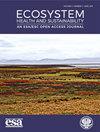气候和土壤因素作为纵向样带植物δ15N驱动因素的相对重要性
IF 3.4
2区 环境科学与生态学
Q1 ECOLOGY
引用次数: 0
摘要
摘要许多研究表明,气候和土壤因素会影响陆地生态系统中氮同位素(δ15N)的变化。然而,气候和土壤控制对植物δ15N的共同变化的相对重要性仍不清楚。为了解决这个问题,在中国北部温带草原的纵向样带上采集了区域尺度的植物(L.chinensis)和土壤样本。利用变量重要性投影(VIP)方法,研究了气候和土壤因素对植物δ15N的影响。我们发现气候和土壤变量分别解释了植物δ15N变化的52.4%和31.2%。年平均降水量(MAP)、土壤氮和年平均温度(MAT)是最重要的变量,但土壤含水量(SWC)、干旱指数(AI)和土壤粘粒含量也是重要的变量。土壤pH值和土壤C:N比值被确定为不重要的变量。此外,基于重要变量(VIP>0.8)建立了一个模拟植物δ15N值的高性能模型。应进一步研究气候和土壤变量之间的相互作用对温带草原氮循环的影响,以提供更可靠的植物δ15N预测。本文章由计算机程序翻译,如有差异,请以英文原文为准。
Relative importance of climatic and edaphic factors as drivers of plant δ15N along a longitudinal transect
ABSTRACT Many studies have shown that climatic and edaphic factors influence the variations in nitrogen isotopes (δ15N) in terrestrial ecosystems. However, the relative importance of co-varying climatic and edaphic controls on plant δ15N remains somewhat unclear. To address this issue, regional-scale plant (L. chinensis) and soil samples were collected along a longitudinal transect across the temperate grasslands in northern China. The influences of climatic and edaphic factors on the plant δ15N were disentangled using the variable importance in projection (VIP) approach. We found that the climatic and edaphic variables explained 52.4% and 31.2%, respectively, of the variation in plant δ15N. The mean annual precipitation (MAP), soil N, and mean annual temperature (MAT) were the most important variables, but the soil water content (SWC), aridity index (AI), and soil clay content were also important variables. The soil pH and soil C: N ratios were identified as unimportant variables. Furthermore, a high-performance model for simulating plant δ15N values was constructed based on the important variables (VIP > 0.8). Further investigations should focus on the effects of the interaction between the climatic and edaphic variables on the N cycles in the temperate grasslands to provide more reliable predictions of plant δ15N.
求助全文
通过发布文献求助,成功后即可免费获取论文全文。
去求助
来源期刊

Ecosystem Health and Sustainability
Environmental Science-Management, Monitoring, Policy and Law
CiteScore
7.10
自引率
2.00%
发文量
40
审稿时长
22 weeks
期刊介绍:
Ecosystem Health and Sustainability publishes articles on advances in ecology and sustainability science, how global environmental change affects ecosystem health, how changes in human activities affect ecosystem conditions, and system-based approaches for applying ecological science in decision-making to promote sustainable development. Papers focus on applying ecological theory, principles, and concepts to support sustainable development, especially in regions undergoing rapid environmental change. Papers on multi-scale, integrative, and interdisciplinary studies, and on international collaborations between scientists from industrialized and industrializing countries are especially welcome.
Suitable topics for EHS include:
• Global, regional and local studies of international significance
• Impact of global or regional environmental change on natural ecosystems
• Interdisciplinary research involving integration of natural, social, and behavioral sciences
• Science and policy that promote the use of ecological sciences in decision making
• Novel or multidisciplinary approaches for solving complex ecological problems
• Multi-scale and long-term observations of ecosystem evolution
• Development of novel systems approaches or modeling and simulation techniques
• Rapid responses to emerging ecological issues.
 求助内容:
求助内容: 应助结果提醒方式:
应助结果提醒方式:


